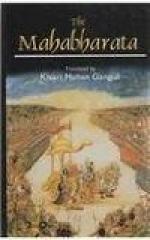172. These words of the king are intended to be reported to his queen who would understand the allusion. The sense is this: cursed by Vasishtha, I have become a cannibal. My condition is intolerable. By this gift of the ear-rings to a deserving Brahmana, much merit may arise. That merit may relieve me.
173. This also is an allusion to the dreadful curse of Vasishtha. The king refers to Madayanti as his only refuge. She may save him by doing an act or special merit, viz., giving away her costly ear-rings to a truly deserving Brahmana.
174. The sense is this: a Brahmana is never loose of tongue. He is truthful. Hence, having passed my word to thee about my return, thou mayst be sure that I would keep my word. One, again, that acts improperly towards a friend, comes to be regarded as a thief. By this, Utanka reminds the king that he should not inflict any wrong on him by carrying out his intention of eating him up.
175. Vilwa is the Aegle marmalos.
176. Chamu here is used in a general sense, viz., a division. Of course it stands for an Akshauhini.
177. Kavi or Kavya is another name of Sukra, the preceptor of the Daityas.
178. Krishna implies Vyasa here. The great Rishi was called ’the island-born Krishna’.
179. The commentator explains that by the constellation Dhruba is implied Rohini and the Uttaras numbering three. Sunday, again is called the Dhruba-day.
180. Agnivesya was another name of Dhaumya.
181. Three roads running north to south, and three running cast to west and intersecting the former, are the six roads that are directed to be laid out in pitching encampments. Those give nine squares with two boundary lines at right angles with each other.
182. Karaputa is made up of two wooden chests united with each other by chains or cords and intended to be borne by camels and bullocks.
183. The first line of 17 is exceedingly terse. Literally rendered, it runs,—’Each vessel was united with another, and became half the (total) weight slung on balance.’
184. Vilava is Arjuna.
185. Before performing any rite or act of a grave nature, Hindus are required to touch water or perform what is called the ‘achamana’. A little quantity of water is taken on the palm of the right hand, and with it are touched the lips, the nostrils, the ears, and the eyes.
186. The abode of Vaisravana is called Alaka. Vaisravana is, of course, Kuvera, the lord of treasures, friend of Mahadeva, and chief of the Yakshas.
187. The last line is slightly expanded.
188. The sense is this: thou art the eldest brother of the Pandavas; if thou sacrificest, thy brothers also will come to be regarded as sacrificing with thee.
189. Sphya was a wooden sword or scimitar, used for slaying the sacrificial animal. Kurcha is a handful of Kusa grass. All these things are directed by Vyasa to be made of pure gold.




